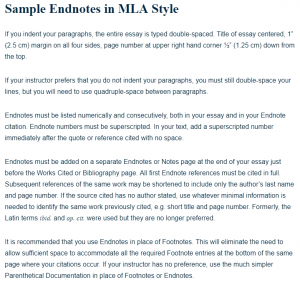Sample Endnotes in MLA Style
If you indent your paragraphs, the entire essay is typed double-spaced. Title of essay centered, 1” (2.5 cm) margin on all four sides, page number at upper right hand corner ½” (1.25 cm) down from the top.
If your instructor prefers that you do not indent your paragraphs, you must still double-space your lines, but you will need to use quadruple-space between paragraphs.
Endnotes must be listed numerically and consecutively, both in your essay and in your Endnote citation. Endnote numbers must be superscripted. In your text, add a superscripted number immediately after the quote or reference cited with no space.
Endnotes must be added on a separate Endnotes or Notes page at the end of your essay just before the Works Cited or Bibliography page. All first Endnote references must be cited in full. Subsequent references of the same work may be shortened to include only the author’s last name and page number. If the source cited has no author stated, use whatever minimal information is needed to identify the same work previously cited, e.g. short title and page number. Formerly, the Latin terms ibid. and op. cit. were used but they are no longer preferred.
Choose the writer to help you with writing and formatting your paper:
It is recommended that you use Endnotes in place of Footnotes. This will eliminate the need to allow sufficient space to accommodate all the required Footnote entries at the bottom of the same page where your citations occur. If your instructor has no preference, use the much simpler Parenthetical Documentation in place of Footnotes or Endnotes.
Recommended reading on Footnote citation MLA.
Jones 1
Tracy Jones
Mr. K. Smith
ENG-4GN-01
18 April 2006
The Many Facets of Taboo
The World Book Encyclopedia defines Taboo as “an action, object, person, or place forbidden by law or culture.”1
An encyclopedia of the occult points out that taboo is found among many other cultures including the ancient Egyptians, Jews and others.2
Mary Douglas has analyzed the many facets and interpretations of taboos across various cultures. She points out that the word “taboo” originates from the Polynesian languages meaning a religious restriction.3 She finds that “taboos flow from social boundaries and support the social structure.”4
In reference to Freak Shows at circuses, Rothenberg makes the observation that people who possess uncommon features and who willingly go out in public to display such oddities to onlookers are acting as “modern-day taboo breakers” by crossing the “final boundary between societal acceptance and ostracism.”5
In traditional British East Africa, between the time of puberty and marriage, a young Akamba girl must maintain an avoidance relationship with her own father.6
Looking at taboo in a modern society, Marvin Harris gives an interesting example of the application of cultural materialism to the Hindu taboo against eating beef.7
Begin your Endnotes page by centering the title Endnotes or Notes 1″ (2.5 cm) or about 6 lines from the top of the page. Double-space your entries, indent each Endnote citation 1/2″ (1.25 cm) or 5 spaces from the left margin, do not indent subsequent lines, add a superscripted Endnote citation number at the beginning of each citation, leave one space after the superscripted number, and list entries in the same numerical order as they appear in the text of your paper.
For samples of numerous other Endnote citations, please see MLA Handbook for Writers of Research Papers, 6th ed., pages 300-313.

Endnotes
1Alan Dundes, “Taboo,” World Book Encyclopedia. 2000 ed.
2 “Taboo,” Occultopedia: Encyclopedia of Occult Sciences and Knowledge,
Site created and designed by Marcus V. Gay, 18 Jan. 2005 <http://www.occultopedia.com/ t/taboo.htm>.
3 Mary Douglas, “Taboo,” Man, Myth & Magic, ed. Richard Cavendish, new ed., 21 vols. (New York: Cavendish, 1994) 2546.
4 Douglas 2549.
5 Kelly Rothenberg, “Tattooed People as Taboo Figures in Modern Society,”
1996, BME / Psyber City, 18 Jan. 2005 <http://bme.freeq.com/tatoo/tattab.html>.
6 Sigmund Freud, Totem and Taboo (New York: Random, 1918) 17.
7 Marvin Harris, “The Cultural Ecology of India’s Sacred Cattle,” Current
Anthropology 1992, 7:51-66, qtd. in McGrath, “Ecological Anthropology,” Anthropological
Theories: A Guide Prepared by Students for Students 19 Oct. 2001, U. of Alabama,
18 Jan. 2005 <http://www.as.ua.edu/ant/Faculty/Murphy/ecologic.htm>.
If your instructor considers your Endnotes to be adequate documentation, you may not be required to complete a Works Cited, References or Bibliography page. Otherwise, a separate page must be added at the end of your paper entitled: Works Cited, References, or Bibliography to include all of the citations already listed on your Endnotes or Notes page. See example below.
Works Cited
Douglas, Mary. “Taboo.” Man, Myth & Magic. Ed. Richard Cavendish. New ed. 21 vols. New York: Cavendish, 1994. 2546-2549.
Dundes, Alan. “Taboo.” The World Book Encyclopedia. 2000 ed.
Freud, Sigmund. Totem and Taboo. New York: Random, 1918.
McGrath, Stacy. “Ecological Anthropology.” Anthropological Theories: A Guide
Prepared by Students for Students. 19 Oct. 2001. U. of Alabama. 18 Jan. 2005
http://www.as.ua.edu/ant/Faculty/Murphy/ecologic.htm>.
Rothenberg, Kelly. “Tattooed People as Taboo Figures in Modern Society.” 1996. BME/Psyber City. 18 Jan. 2005 <http://www.bme.freeq.com/tattoo/ tattab.html;.





